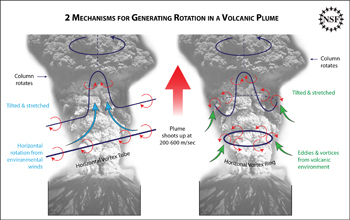博文
火山烟柱形状模型的修正
||
小普林尼(Pliny the Younger)将公元79年维苏威火山喷发所产生烟柱的形状比作意大利伞松的形状。两千年之后的今天,火山烟柱模型仍然将这种烟柱描述为下面一个柱子、上面顶着一把“雨伞”。现在,对最近火山喷发(包括1991年6月皮纳图博火山的喷发)的卫星影像所做的一项新的分析显示,这些模型缺少一个微妙但却关键的特征,即“火山的中气旋”,该气旋使得烟柱中的“柱”和“伞”都绕它们的垂直轴旋转。“火山的中气旋”为火山烟柱中一组各不相同的、人们很不了解的现象提供了一个统一的解释,其中包括龙卷风(水龙卷和尘旋风)、伞形结构的形成、以及在2008年5月智利柴滕火山(Mount Chaiten)喷发期间所观测到的那种壮观的闪电鞘(lightning sheath)的形成等。
Sea captain's historic report, modern photographs, lead scientists to new conclusions
A 200-year-old report by a sea captain and photographs of the 2008 eruption of Mount Chaiten are helping scientists better understand strong volcanic plumes.
In a paper published this week in the journal Nature, the scientists show that the spontaneous formation of a "volcanic mesocyclone"--a rotating, column-shaped vortex--causes the volcanic plume to rotate on its axis.
The rotation, in turn, triggers a sheath of lightning and creates waterspouts or dust devils. The origins of these volcanic phenomena were previously unexplained.
 Two mechanisms for generating rotation in a volcanic plume. |
"These results solve a long-standing mystery about the relationship between volcanic plumes and associated tornadoes, waterspouts and lightning, showing for the first time that rotation of a volcanic plume may be the primary cause of these effects," said Sonia Esperanca, program director in the National Science Foundation's (NSF) geosciences directorate.
The research is supported by NSF, via three directorates: geosciences; mathematical and physical sciences; and engineering.
"Rotation is an essential element of a strong volcanic plume," said Pinaki Chakraborty, a computational scientist and engineer at the University of Illinois and the paper's lead author. "By taking into account the rotation, we can better predict the effects of volcanic eruptions."
In 2008, a photograph of the Mount Chaiten eruption in southern Chile showed what appeared to be a volcanic plume wrapped in a sheath of lightning.
A search for references to other occurrences of lightning sheaths led Chakraborty, mechanical engineer Gustavo Gioia and geologist Susan Kieffer to an obscure paper by a sea captain, published in 1811.
In that paper, the sea captain reported his observations of a volcanic vent that emerged from the sea in the Azores archipelago and formed a large volcanic plume.
According to the captain, the plume rotated on the water "like an (sic) horizontal wheel" and was accompanied by continuous "flashes of lightning" and a "quantity of waterspouts."
This conjunction of rotation, lightning and waterspouts (or dust devils on land) is characteristic of a familiar meteorological phenomenon seemingly unrelated to volcanic plumes: a tornadic thunderstorm.
The same process that creates a mesocyclone in a tornadic thunderstorm also creates a volcanic mesocyclone in a strong volcanic plume, Chakraborty said. "What happens in tornadic thunderstorms is analogous to what happens in strong volcanic plumes."
A strong volcanic plume consists of a vertical column of hot gases and dust topped with a horizontal "umbrella." A volcanic mesocyclone sets the entire plume rotating on its axis.
The mesocyclone spawns waterspouts or dust devils, and groups the electric charges in the plume to form a sheath of lightning, as was so prominently displayed in the eruption of Mount Chaiten.
On June 15, 1991, the eruption of Mount Pinatubo in the Philippines was recorded by a satellite snapping hourly images. The images show that the edge of Pinatubo's umbrella was rotating about its center, consistent with the presence of a volcanic mesocyclone, say the scientists.
Satellite images of future volcanic plumes taken at intervals of a few minutes would make it possible to trace the evolution of umbrellas in detail, Gioia said.
In addition, some of the tools commonly used in the study of thunderstorms could be deployed for the study of volcanic eruptions.
"The structure and dynamics of volcanic mesocyclones, as well as the presence of lightning sheaths, might be verified with Doppler radar and lightning mapping arrays, two technologies that have been scarcely used in volcanology," Gioia said.
The National Science Foundation (NSF) is an independent federal agency that supports fundamental research and education across all fields of science and engineering, with an annual budget of $6.06 billion. NSF funds reach all 50 states through grants to over 1,900 universities and institutions. Each year, NSF receives about 45,000 competitive requests for funding, and makes over 11,500 new funding awards. NSF also awards over $400 million in professional and service contracts yearly.
Contacts:
Cheryl Dybas, NSF (703) 292-7734 cdybas@nsf.gov
Jim Kloeppel, University of Illinois (217) 244-1073 kloeppel@illinois.edu
https://wap.sciencenet.cn/blog-5422-222854.html
上一篇:VC 双缓冲绘图
下一篇:创新的分类